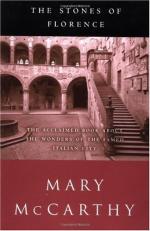
|
| Name: _________________________ | Period: ___________________ |
This test consists of 15 multiple choice questions and 5 short answer questions.
Multiple Choice Questions
1. As mentioned in Chapter 3, what does the surname "Bevisangue" mean?
(a) "Cold-blooded."
(b) "Goldenhearted."
(c) "Blood-drinker."
(d) "Ruthless."
2. How did Florentine art express the concept of infamy?
(a) Through pen and ink drawings.
(b) Through painting.
(c) Through fresco.
(d) Through bas relief sculpture.
3. What structure in the Piazza della Republica celebrates progress?
(a) The triumphal arch.
(b) The statue of a galloping horse.
(c) The statue of Pope Pius IX.
(d) The bridge over the canal.
4. As mentioned at the end of Chapter 1, who hid in the German Institute during World War II?
(a) Communists.
(b) Anti-Nazis.
(c) Nazis.
(d) Fascists.
5. Who is the person mentioned in Chapter 3 who did not exact revenge from someone he came across on Good Friday?
(a) Cosimo il Vecchio.
(b) Michelangelo.
(c) Uberti.
(d) Saint Giovanni Gualberto.
6. What was the function of medieval towers?
(a) Storage.
(b) Guest space.
(c) Self-defense.
(d) Aesthetics.
7. According to the author's opinion as stated in Chapter 1, Italians are not what?
(a) "Willing to sit in traffic."
(b) "Fastidiously religious."
(c) "Civic-minded."
(d) "Accustomed to fast food."
8. What is the name of Michelangelo's famous sculpture, which is mentioned in the first paragraph of Chapter 1?
(a) David.
(b) The Trinity.
(c) The Pieta.
(d) Moses.
9. What does the author call "an incubus on its present population"?
(a) Historic Florence.
(b) The Ponte Vecchio.
(c) The David.
(d) The Pieta.
10. What was the home of the Roman governor called?
(a) The Piazza del Campidoglio.
(b) The Piazza del Gubernador.
(c) The praetorium.
(d) The Sanhedrin.
11. What adjective does the author use to describe Venice and Siena in Chapter 1?
(a) Modern.
(b) Suave.
(c) Feminine.
(d) Industrial.
12. Which church does the author describe in Chapter 2 as "half a grain depot to be used in case of emergency, siege, or famine"?
(a) Orsanmichele.
(b) Santa Croce.
(c) The Bargello.
(d) The Duomo.
13. What buildings in rural Tuscany survived the medieval wars between the nobility and the people?
(a) Convents.
(b) Inns.
(c) Palaces.
(d) Libraries.
14. What is the color scheme of the Baptistery?
(a) Pink and brown.
(b) Blue and gold.
(c) Black and white.
(d) Grey and brown.
15. As discussed in Chapter 3, who defiled Savonarola's pulpit?
(a) The Bad Companions.
(b) Various Inquisitors.
(c) Guelph peasants.
(d) Il Postino.
Short Answer Questions
1. What was the height limit of medieval Florentine towers?
2. According to the author, who is the only person who can observe Florence well?
3. Who eventually renounced his nude sculpture "Neptune"?
4. According to the medieval conception of Florence, which city is Florence's mother?
5. What type of political speech does Chapter 3 describe as occurring frequently in Florence since medieval times?
|
This section contains 414 words (approx. 2 pages at 300 words per page) |

|




